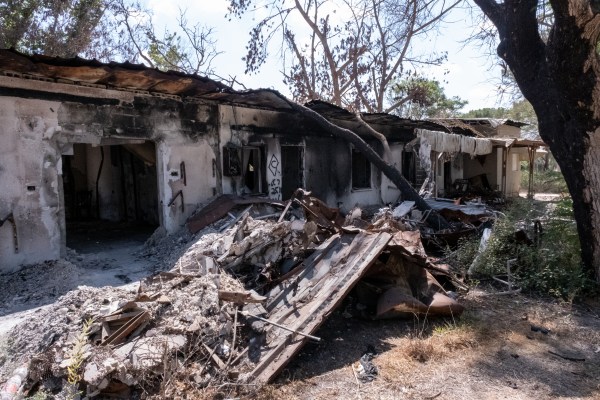Happy Friday! Though we’re counting down the days until the election with great trepidation, we’re much more enthusiastic about the countdown to the inaugural Dispatch Summit, now just 25 days away! Join us on November 12 at The National Press Club in Washington, D.C., as we make sense of whatever happens on November 5 and what comes next. Get your ticket here!
Quick Hits: Today’s Top Stories
- The Israel Defence Forces (IDF) announced on Thursday that Yahya Sinwar, the leader of Hamas in Gaza and architect of the terrorist attacks of October 7, 2023, had been killed. The body of the terrorist leader—who had been in hiding for the past year in Gaza and was believed to be closely overseeing Hamas military operations—was discovered among the rubble of a building fired on by an Israeli tank during a “routine operation.” The body was later confirmed, through DNA testing, to be that of Sinwar. Israeli Prime Minister Benjamin Netanyahu called Sinwar’s death “the beginning of the day after Hamas.” President Joe Biden called Netanyahu on Wednesday, and the pair reportedly agreed the terrorist leader’s death presented an opportunity for a renewed push to secure the release of the more than 100 hostages Hamas is still holding in Gaza.
- U.S. Central Command announced Wednesday that U.S. military stealth bombers struck five Houthi targets in Yemen on Wednesday evening. U.S. Defense Secretary Lloyd Austin confirmed that the Air Force deployed B-2 stealth bombers to target underground weapons storage facilities and emphasized American resolve in the campaign against the Houthis’ disruption of global shipping through the Red Sea.
- The independent, bipartisan panel tasked with investigating the Secret Service failures that led to the nearly successful assassination attempt against former President Donald Trump in July released its findings on Thursday. The panel of four former senior law enforcement and government officials identified an absence of “critical thinking” among agents and a “lack of ownership” of decisions among agents it interviewed. The report also found “little in the way of self-reflection in terms of identifying areas of missteps, omissions or opportunities for improvement” among the Secret Service. In a letter to Homeland Security Secretary Alejandro Mayorkas, the panel wrote that the “Secret Service requires fundamental reform to carry out its mission,” adding that “without that reform, the Independent Review Panel believes another Butler can and will happen again.” Acting Director of the Secret Service Ronald Rowe Jr. responded to the report on Thursday, saying that the agency will “continue to work with the department to look at those recommendations that are actionable and feasible to make changes in the Secret Service.”
- The Justice Department (DOJ) indicted an Indian government employee, Vikash Yadav, on Thursday on murder-for-hire and money laundering charges in connection to an alleged plan to murder a U.S. citizen Sikh separatist. Last year, the DOJ charged Nikhil Gupta, Yadav’s alleged co-conspirator, with attempting to kill the dissident. The indictment follows Canadian officials’ claims this week that Indian diplomats—six of whom were expelled from Canada—were involved in intelligence gathering on Sikh dissidents in Canada, passing the information gleaned to the Indian government and to Indian crime networks to target the separatists.
- U.S. President Joe Biden traveled to Europe on Thursday for a meeting in Berlin with the leaders of Germany, France, and the United Kingdom. Talks are expected to focus on the countries’ approach to the conflicts raging in Ukraine and the Middle East. The trip was originally set for earlier this month but was delayed due to Hurricane Milton.
- Revised figures from the FBI reportedly show that violent crime in the U.S. actually increased in 2022 rather than decreased, as the agency had previously reported. Data published last year had shown a 1.7 percent decrease in violent crime, but after the revision—which was not publicly flagged and first reported by RealClearInvestigations—it appears that violent crime increased by more than 4 percent from 2021 to 2022.
- A court in Bangladesh issued an arrest warrant for former Prime Minister Sheikh Hasina, who fled the country to India in August following mass protests against her government. Hasina—who led the country from 1996 to 2001 and then since 2009—became progressively autocratic during her tenure, as critics accused her of politically motivated arrests, repressions, extrajudicial killings, and rigged elections. Bangladesh’s International Criminal Tribunal accused Hasina of “crimes against humanity” for her role in the violent suppression of protests. While India and Bangladesh have a mutual extradition treaty, it contains a clause saying that extradition of a “political character” can be refused.
- A grand jury on Thursday reportedly indicted both a 14-year-old shooter and his father, Colin Gray, on murder charges related to a mass shooting at a high school in Georgia in September. Four teachers and students were killed in the shooting at Apalachee High School, and nine others were wounded. The shooter is being charged with 55 counts—including four counts of felony murder—while his father is charged with 29 counts, including second-degree murder, involuntary manslaughter, and reckless conduct. Prosecutors seek to hold Colin Gray responsible for buying his son guns and declining his request to take him to a “mental asylum” shortly before the shooting.
- Liam Payne, a former member of the boy band One Direction, died on Wednesday after falling off of a third-story hotel balcony in Buenos Aires, Argentina. Before his fall, staff at the hotel where he was staying reportedly called the police about a guest who appeared to be under the influence of drugs or alcohol. Payne was 31 years old.
Hamas Leader Yahya Sinwar Dead by Israeli Fire

Israeli troops operating in southern Gaza killed Hamas leader Yahya Sinwar on Wednesday, just over a year after the terrorist chief plunged the Middle East into war with the mass murder and abduction of Israelis and others on October 7, 2023. An Islamic fundamentalist with a reputation for killing his own people in pursuit of Israel’s eradication, the 62-year-old’s death set off a wave of celebrations across Israel and sparked both trepidation and optimism for the future of the remaining hostages in Gaza.
The Israel Defense Forces (IDF) publicly confirmed Sinwar’s death just before 8 p.m. local time on Thursday, after soldiers in Gaza’s southernmost city of Rafah discovered a corpse resembling the Hamas leader in the wreckage of a firefight that took place the day prior. Forensic teams later confirmed Sinwar’s identity using dental records and fingerprints obtained from his time in Israeli prison. Sinwar was reportedly carrying cash, a rifle, and a pack of Mentos at the time of his killing, which the IDF said wasn’t targeted based on intelligence about his whereabouts but was rather the result of routine clearing operations in the evacuated neighborhood.
In what the IDF says is drone footage of Sinwar’s final moments, a man in a headscarf can be seen crouching behind a chair, armed only with some kind of stick. As the drone hovers in front of him, the clearly injured man feebly throws it at the drone, which easily avoids being hit.
The terrorist chief’s death marks one of Israel’s key successes in a war brought on by the October 7 attack—a scheme Sinwar himself hatched over many years. As Hamas’ Gaza leader, he openly called for Israel’s destruction and eventually attempted to bring it about, killing 1,200 people, mostly civilians, and kidnapping 251 others in the opening salvo of a conflict he hoped would draw in other Iranian allies in the region.
Though Sinwar succeeded in igniting other fronts in the war with Israel, his goal of delivering a death blow to the Jewish State backfired in more ways than he likely imagined. His death not only followed the effective demilitarization of Hamas in Gaza through a yearlong IDF ground campaign but also the killing of other terror chiefs in Iran’s axis, including Hamas leader-in-exile Ismail Haniyeh in July and Hezbollah leader Hassan Nasrallah last month.
“This was a disastrous endeavor,” Nadav Eyal, a prominent Israeli political commentator and journalist, told The Dispatch. “It led not only to his own death and the actual effective occupation of Gaza—and of course the deaths of many, many of his own people—but also to major damages to the entire axis that he was part of, to a loss of deterrence by Iran, to the killing of Hassan Nasrallah and his deputies, and many other developments that he didn’t foresee. He miscalculated Israeli resolve to act against him, even after October 7.”
Sinwar’s death brings to fruition a promise by Israeli Defense Minister Yoav Gallant last year to track down the planners and perpetrators of the biggest massacre of Jews since the Holocaust. “This is a clear message to all of our enemies,” he said Wednesday. “The IDF will reach anyone who attempts to harm the citizens of Israel or our security forces, and we will bring you to justice.”
For the family members of Israeli hostages still in Gaza, the news generated cautious optimism. Sinwar’s killing marks a period of great uncertainty but also of opportunity. According to U.S. officials pushing for a ceasefire-for-hostage release deal, the slain terror chief had been the biggest hurdle in reaching an agreement to end the war. President Joe Biden hailed the news of the Sinwar strike as “a good day for Israel, for the United States, and for the world” in a statement Thursday. “Yahya Sinwar was an insurmountable obstacle to achieving all of those goals,” he said, referring to efforts toward a Gaza no longer ruled by Hamas. “That obstacle no longer exists. But much work remains before us.”
U.S. and Israeli officials now hope to leverage the blow to Hamas to achieve one of its last remaining war goals in Gaza: freeing the hostages. In a speech Thursday night, Israeli Prime Minister Benjamin Netanyahu called on Hamas fighters to lay down their arms and warned them not to harm the abductees in their charge. “This war can end tomorrow,” he said Thursday. “It can end if Hamas lays down its arms and returns our hostages.”
“This might be a window of opportunity to reach an agreement in Gaza in which Hamas would not be part of the new government in Gaza and for the Israelis to say candidly that they have won this war. There is no military threat that Hamas poses in Gaza, although it still exists,” Eyal said. “For Israel, it’s much easier now to reach agreements knowing that Sinwar, who was a messianic leader devoted to fundamentalism, is now dead.”
Preparing for an AI Energy Boom
In 1979, the United States witnessed its worst-ever nuclear power accident at the Three Mile Island plant in Middletown, Pennsylvania. The partial meltdown of one of the reactors resulted in some radioactive gas being released into the environment. Years of subsequent testing and research have shown the incident produced negligible health or environmental effects on the surrounding area. But Three Mile Island nevertheless heralded the beginning of a long decline for nuclear power in the U.S. spurred by public anxiety, anti-nuclear environmental groups, and a costly and burdensome regulatory regime that developed in reaction to the accident.
Almost a half-century later, an unlikely industry is helping to arrest nuclear’s decline: Big Data.
Microsoft, the software company turned cloud computing giant, announced in September a deal with Constellation Energy to bring Three Mile Island—shuttered in 2019—back online. The deal preceded announcements from Amazon and Google this week of their own nuclear power deals as tech giants look to secure reliable electricity sources to power the engines of the artificial intelligence (AI) boom, data centers. Energy researchers hope these kinds of private investments can help drive the green energy transition, but they still worry that the current and projected demand for electricity could test the limits of the U.S. electrical grid.
For much of the past decade, U.S. electricity demand remained relatively flat thanks to a confluence of factors: among them, the fallout of the 2008 recession, a decline in domestic manufacturing, and an increase in the efficiency of electricity end-use consumption—think LED light bulbs versus incandescent. But the demand curve has begun to rise again in recent years accompanied by projections of significant growth over the next decade. The Department of Energy concluded that the U.S. is “returning to a period of rapid electricity demand growth,” where energy requirements grow by 15 to 20 percent in the next decade and double by 2050. Part of the increase will be driven by a rise in domestic manufacturing and the electrification of more sectors like transportation—for example with electric vehicles.
But one of the fastest-growing sources of demand is data centers. Most of the online world relies on some form of cloud computing and data storage, enabled by giant facilities packed with servers, routers, and hard drives. Data centers provide the traditional computing power behind surfing the web, streaming movies and TV, and the Google docs your Morning Dispatchers use to put together this newsletter every day. The electricity cost of a Google search doesn’t end with your laptop battery or your Wifi router; it continues all the way to the data facilities powering the search and, in particular, the energy required to cool those facilities—think of the cooling fan system in your computer but at the scale of a Costco warehouse.
In 2022, data centers accounted for around 1 percent of global energy consumption, according to estimates from the International Energy Association, and that consumption has already been steadily increasing. “Between 2017 and 2021, electricity used by Meta, Amazon, Microsoft, and Google—the main providers of commercially available cloud computing and digital services—more than doubled,” the Electric Power Research Institute (EPRI) noted in a May report.
But AI could supercharge that consumption. It takes enormous amounts of energy to train the large language models (LLMs) behind AI products like ChatGPT, as Joe Polidoro explained for the site in March. Once the models are trained, user queries—known as inferences—use small amounts of energy compared to the training process. But if ChatGPT requests fully replace traditional internet searches, the increased energy cost in the aggregate could be huge.
Estimates of the early ChatGPT model found that an LLM query required 2.9 watt-hours of energy, compared to 0.3 watt-hours for a Google search. Using AI to generate images, video, and audio would likely require even more energy. Fueled by the AI boom, EPRI estimated that in a “high-growth scenario” data centers could consume more than 9 percent of U.S. electricity, more than double current consumption, by 2030.

Projecting AI electricity demand is inherently challenging due partly to efficiency gains. Data center power demand from 2010 to 2020 was largely offset by efficiency gains in electricity use at the facilities, according to EPRI. The largest data center users have begun building more efficient, “hyperscale” facilities dedicated to AI use. But even those efficiency gains could struggle to temper the electricity consumption driven by AI’s exponential data and computing demands.
Regardless, the potential for big jumps in power consumption is strong enough for the data giants to put up serious capital for new nuclear energy projects. Microsoft’s power purchase agreement with the Three Mile Island facility provides the tech company with access to 100 percent of the plant’s energy for 20 years. The move is part of the company’s zero emissions goal and follows years of wind and solar power agreements. But data giants are now recognizing that wind and solar alone won’t be able to provide the constant supply of energy that data centers require. Nuclear power offers the potential of emissions-free, 24/7 energy.
“Powering industries critical to our nation’s global economic and technological competitiveness, including data centers, requires an abundance of energy that is carbon-free and reliable every hour of every day, and nuclear plants are the only energy sources that can consistently deliver on that promise,” Joe Dominguez, the president and CEO of Constellation, the energy company, said when the Microsoft project was announced.
Amazon and Google have invested in the longer-term development of small modular nuclear reactors (SMRs)—newer reactors that have yet to be used commercially but which many in the industry see as the future of lower-cost nuclear power. SMRs are cheaper to produce than larger, traditional nuclear reactors, and in theory, they should require less costly safety regulations, assuming the Nuclear Regulatory Commission (NRC) agrees. The modular nature of SMRs would also make it easier to right-size power production for specific projects and scale them up as needed.
“The key with nuclear is you have to pick something and build a lot of it to make it cheap,” said Rich Powell—the head of the Clean Energy Buyers Association, a trade group whose members include Microsoft, Amazon, and Google, and which works to leverage the companies’ aggregate power demand to finance energy projects.
Despite the growth of new projects, companies could face challenges in getting new sources of energy plugged into the grid fast enough to meet growing demand. The process, known as interconnection, can be lengthy and requires navigating a sea of bureaucracy and regulations. “It takes two years to build a data center,” Lynne Kiesling—the director of the Institute for Regulatory Law and Economics at Northwestern University—told TMD. “It takes three plus years to build a gas plant, probably three to four years to build a wind or solar plant, and in regions other than Texas, it takes six years to get it connected [to the grid.]”
“The crunch point is going to be unavoidable,” she added.
Pennsylvania Gov. Josh Shapiro sent a letter last month to PJM Interconnection—the retail transmission organization that manages electricity on the grid for much of the Northeast—urging the company to expedite its backlogged interconnection review process to quickly facilitate the Three Mile Island restart. Shapiro, a once and likely future national political figure, gained renown in 2023 for cutting red tape and waiving bureaucratic requirements to reopen I-95 just days after a tanker truck fire collapsed an overpass in Philadelphia.
The sclerotic and heavily regulated power and utility industry could drive some tech companies to pursue projects that bypass the grid, contracting with providers to construct power facilities at or near their data centers and connect them on private wires. But that comes with challenges of its own. “On-site self-generation provides more control but requires expertise in power systems, regulatory compliance, and maintenance,” Kiesling wrote in an essay on the “make or buy” question facing data companies. “That expertise entails a significant expansion of the firm to implement that vertical integration. It’s a big capital and managerial change.”
Oracle’s CEO Larry Ellison tipped off investors in a September earnings call that the company was designing and building a data center that would be powered by three SMRs on site. Ellison acknowledged how “bizarre” it was that his company is involved in the nuclear business but noted, “this is how crazy it’s getting.” The details and timing of the project are unclear, but Ellison’s public description suggests power production and transmission outside of the grid.
With the uncertainty around the exact level of future energy demand from data centers, some analysts are glad to see private efforts to shake up power production. Plus, a more centralized, government-financed effort to build out electricity capacity to power AI companies could end badly since there’s a non-trivial chance the industry is on the cusp of a bubble. Most, if not all, of these private nuclear projects will still benefit from large government subsidies and tax breaks.
“I’m all in favor of having private capital bear the risk,” Kiesling told TMD. “Otherwise, if you build all that kind of generation, and then the demand doesn’t show up, and then you have what’s called a stranded cost, and stranded costs are expensive, and it raises rates for everyone.”
Worth Your Time
- America has an eloquence problem, James Hankins argued in Law and Liberty. “Everyone knows that American politicians (unlike British ones) are as a rule incompetent public speakers, unable to express their thoughts or persuade people to accept their policies,” he wrote. “Laments are heard on all sides these days that our politicians lack courage. But as Cicero observed, a man is more likely to speak with courage when he knows how to speak and has confidence in his ability to persuade. In the eyes of humanist educators since Isocrates, the acquisition of eloquence was a moral discipline intended to persuade and forge consensus in states; the man who acquired eloquence had acquired an indispensable tool of political leadership. For traditional humanist educators, the ideal orator would, like Cicero, denounce tyranny and corruption and preserve the republic from its enemies. Moreover, being able to speak your mind with power and beauty makes you fully human and thus able to contribute more excellence (or virtue) to the human community.”
Presented Without Comment
U.S. News and World Report: We Created a Monster: Trump Was a TV Fantasy Invented for ‘The Apprentice’
I want to apologize to America. I helped create a monster.
For nearly 25 years, I led marketing at NBC and NBCUniversal. I led the team that marketed “The Apprentice,” the reality show that made Donald Trump a household name outside of New York City, where he was better known for overextending his empire and appearing in celebrity gossip columns.
To sell the show, we created the narrative that Trump was a super-successful businessman who lived like royalty. That was the conceit of the show. At the very least, it was a substantial exaggeration; at worst, it created a false narrative by making him seem more successful than he was.
In the Zeitgeist
We’re about a week late to this one, but jazz pianist Jon Batiste’s interpretation of Beethoven’s “Für Elise” is … perhaps the greatest rendition we’ve ever heard.
Toeing the Company Line
- In the newsletters: The Dispatch Politics crew reported from Wisconsin about the tight U.S. Senate race between Tammy Baldwin and Eric Hovde, Will dug into the present-day implications of a scuttled North Carolina dam project, and Nick argued (🔒) that right-wing outlets are priming their viewers to believe a Trump loss next month can only be explained by fraud.
- On the podcasts: Sarah, Jonah, and Declan are joined on The Dispatch Podcast by Megan McArdle to discuss Kamala Harris’ recent media blitz and the value of “steelmanning” arguments you don’t agree with.
- On the site: Joseph Polidoro explains the deregulatory process that allowed Apple to turn its AirPods into FDA-approved hearing aids, and Kevin pens a succinct case against Trump.
Let Us Know
Do you think Sinwar’s death is a precursor to the end of the war in Gaza?









Please note that we at The Dispatch hold ourselves, our work, and our commenters to a higher standard than other places on the internet. We welcome comments that foster genuine debate or discussion—including comments critical of us or our work—but responses that include ad hominem attacks on fellow Dispatch members or are intended to stoke fear and anger may be moderated.
With your membership, you only have the ability to comment on The Morning Dispatch articles. Consider upgrading to join the conversation everywhere.